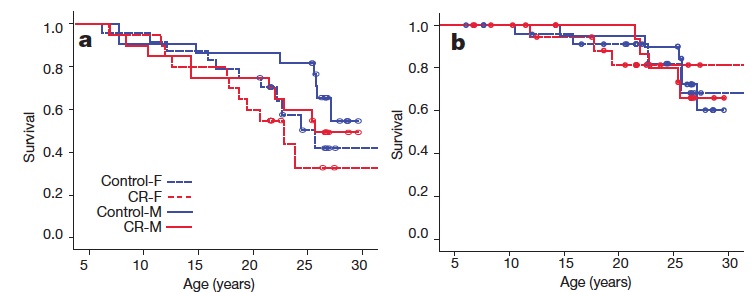1. sorry I'm reading my questions above and realize... how tired I was at 3 am; hem..

The only potential valid point is the last one, which was floating in my head and therefore badly explained:
Somehow you make the point that the NIA data statistically rejects the "Disminishing Returns" Hypothesis :
young-onset CR afforded very substantial protection against malignant neoplastic disease at NIA (6/46 AL cases, of which 5 were fatal, vs. 0/40 cases in CR), while old-onset CR did not (6/18 vs 7/17).
So you statistically make the point for cancer.
We-e-el, that's not really a
statistical point, as I imagine you realize: it just
looks, prima facie, 'suspicious,' and when you combine it with the long latency period of cancer, it seems a reasonable hypothesis that CR "worked" against cancer in these animals — given enough time. (One fly in that ointment, it should be said (and I maybe should'a said in the post) is that Spindler found the late-life effect against cancer to be fairly rapid-onset in mice.(1,2) There might be differences on that front because the sheer
number of cells required for a tumor to kill a mouse is smaller than what's needed to cause problems for humans or primates, and it needn't metastasize — but, of course, that could affect the
efficacy of CR as well as the time-course.
Should the point be valid for lifespan as well? Then I guess, at the risk of caricaturing,
out of the 2 studies we are mostly left with one likely interpretation, a "Dose-Response" one: CR extends lifespan in young-onset monkeys, at least via cancer protection
We can't make he point for lifespan, because even when you look just at younger-onset animals, the survival curves don't seem to have any kind of signal in them:

Total (a) and age-related (b) mortality.
... if anything, the CR animals kind of seem to have fared
more poorly, tho' we don't have the numbers and they tell us there wer no significant differences. It would sure be nice to have one without the 'contamination' of the 'Aberdeen' monkeys, of course. But it would
really be nice to have had more animals and more rigorous CR from the get-go.
References1: Dhahbi JM, Kim HJ, Mote PL, Beaver RJ, Spindler SR. Temporal linkage between the phenotypic and genomic responses to caloric restriction. Proc Natl Acad Sci U S A. 2004 Apr 13;101(15):5524-9. Epub 2004 Mar 25. PubMed PMID: 15044709; PubMed Central PMCID: PMC397416.
2: Spindler SR, Dhahbi JM. Conserved and tissue-specific genic and physiologic responses to caloric restriction and altered IGFI signaling in mitotic and postmitotic tissues. Annu Rev Nutr. 2007;27:193-217. Review. PubMed PMID: 17428180.
















































